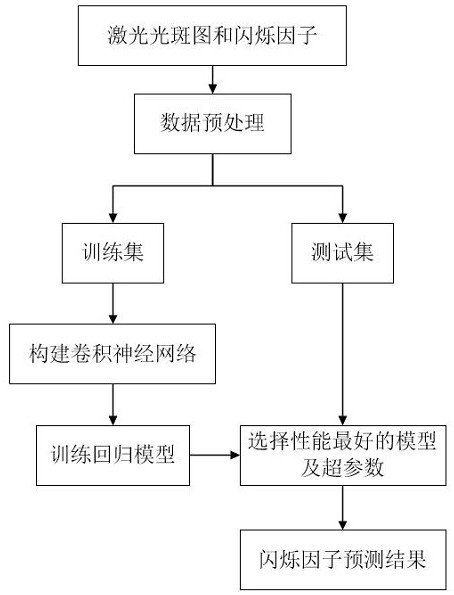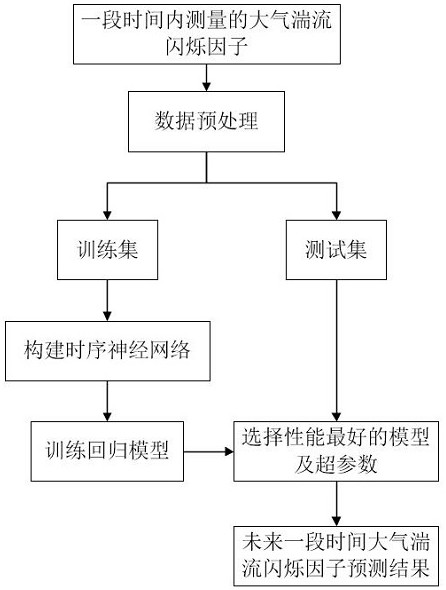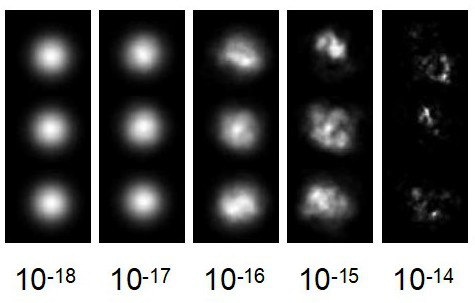Laser atmospheric flicker index prediction method and system
A technology of atmospheric scintillation and scintillation index, which is applied in the fields of laser engineering and optical communication, can solve problems such as time-consuming, poor robustness, and difficulty in eliminating the influence of external noise factors, and achieve the effects of accurate prediction, simple calculation, and avoiding the influence of external noise factors
- Summary
- Abstract
- Description
- Claims
- Application Information
AI Technical Summary
Problems solved by technology
Method used
Image
Examples
Embodiment 1
[0038] Present embodiment 1 is a kind of laser atmospheric scintillation index prediction method, comprises the following steps:
[0039] Step S1: Construct the atmospheric turbulence simulation model, record the light intensity pattern after the reference beam passes through the atmospheric turbulence simulation model, and calculate the scintillation index after the reference beam passes through the atmospheric turbulence simulation model;
[0040]Step S2: Send the light intensity pattern and scintillation index as training data into the neural network for training to obtain a trained neural network model; use the trained neural network model to predict the scintillation index of the unknown light beam.
[0041] In this embodiment 1, the existing data generated by the reference beam (including the light intensity pattern and the scintillation index corresponding to the light intensity pattern) are used as training data to train the neural network to form a mature atmospheric s...
Embodiment 2
[0059] Present embodiment 2 is a kind of laser atmospheric scintillation index prediction method on the basis of embodiment 1, comprises the following steps:
[0060] Step A: In Example 2, a random phase screen is used to simulate atmospheric turbulence, and the transmission of light beams in the atmosphere is equivalent to "free space transmission + phase screen". The distribution of the phase screen is constructed according to the atmospheric model.
[0061] 1. Random phase screen simulation process:
[0062] (1) First put the random complex numbers that obey the standard normal distribution into the N×N matrix middle;
[0063] (2) It is then filtered with a random phase spectrum.
[0064] which is: . in: represents the random phase spectrum, Represents an N×N matrix ,
[0065] is the phase screen spacing;
[0066] ,
[0067] is the refractive index structure constant; , Generally take 2mm, k is the size of the spatial frequency, , L 0 Generally ...
Embodiment 3
[0091] Present embodiment 3 is on the basis of embodiment 2,
[0092] 1. Use MATLAB to numerically simulate the light intensity and scintillation index of the reference beam after passing through atmospheric turbulence. The effect of atmospheric turbulence on the beam is simulated using a random phase screen. Specifically: the beam is first transmitted through a certain distance in free space, and then a phase plate is added, and the distribution of the phase plate is constructed according to the atmospheric model; then it is transmitted through a certain distance in free space, and a phase plate is added; Transmission of similar structures.
[0093] 2. The light intensity map of the simulated Gaussian beam after passing through different intensities of atmospheric turbulence, the turbulence intensity is used Indicates that the range is 10 -18 -10 -14 . Among them, the turbulence intensity in each order of magnitude is divided into 2000, and the simulated beam passes thr...
PUM
 Login to View More
Login to View More Abstract
Description
Claims
Application Information
 Login to View More
Login to View More - R&D
- Intellectual Property
- Life Sciences
- Materials
- Tech Scout
- Unparalleled Data Quality
- Higher Quality Content
- 60% Fewer Hallucinations
Browse by: Latest US Patents, China's latest patents, Technical Efficacy Thesaurus, Application Domain, Technology Topic, Popular Technical Reports.
© 2025 PatSnap. All rights reserved.Legal|Privacy policy|Modern Slavery Act Transparency Statement|Sitemap|About US| Contact US: help@patsnap.com



